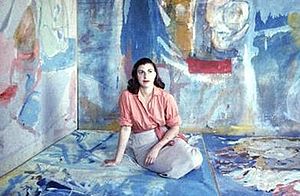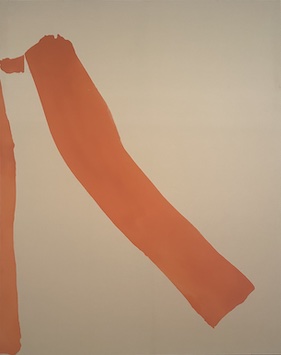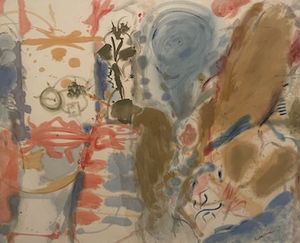Helen Frankenthaler facts for kids
Quick facts for kids
Helen Frankenthaler
|
|
|---|---|

Frankenthaler in 1956
|
|
| Born | December 12, 1928 New York City, US
|
| Died | December 27, 2011 (aged 83) |
| Education | Dalton School Bennington College |
| Known for | Abstract painting |
|
Notable work
|
Mountains and Sea |
| Movement | Abstract expressionism, color field painting, lyrical abstraction |
Helen Frankenthaler (born December 12, 1928 – died December 27, 2011) was an American painter. She was a very important artist in American painting after World War II. She showed her art for over sixty years, from the early 1950s until 2011.
Frankenthaler created new and changing artworks throughout her career. She started showing her large abstract paintings in museums and galleries in the early 1950s. Her work was part of a famous exhibition in 1964 called Post-Painterly Abstraction. This show introduced a new style of abstract painting known as color field. Helen Frankenthaler was born in Manhattan. She was inspired by other artists like Hans Hofmann and Jackson Pollock. Her art has been shown in many special exhibitions around the world since the 1950s. In 2001, she received the National Medal of Arts, a high honor for artists in the U.S. She had a home and art studio in Darien, Connecticut.
Contents
Early Life and Education
Helen Frankenthaler was born in New York City on December 12, 1928. Her father, Alfred Frankenthaler, was a judge. Her mother, Martha, came from Germany with her family. Helen had two older sisters, Marjorie and Gloria.
She grew up in a cultured and progressive family in Manhattan. Her family encouraged all three daughters to have professional careers. Helen studied at the Dalton School with the muralist Rufino Tamayo. She also attended Bennington College in Vermont. At Bennington, her teacher Paul Feeley helped her understand how to arrange pictures.
After college in 1949, she studied art privately. She also studied with Hans Hofmann in 1950. In 1950, she met Clement Greenberg, an art critic. She later married Robert Motherwell in 1958, who was also a painter. They were known for their lively parties. They divorced in 1971. In 1994, Frankenthaler married Stephen M. DuBrul, Jr., an investment banker.
Style and Technique
Helen Frankenthaler painted for almost sixty years. Her style changed many times. She was first linked to abstract expressionism. This style focuses on shapes found in nature. Frankenthaler used fluid shapes, abstract forms, and flowing lines. She often painted on large canvases. Her art usually had simple abstract designs.
She believed in painting with spontaneity. Frankenthaler once said, "A really good picture looks as if it's happened at once." Her official art career began in 1952 with her painting Mountains and Sea. In the 1950s, her paintings often had the main action in the middle. The edges of the canvas were less important.
In 1957, she started trying out linear shapes. She also used more organic, rounded forms. By the 1960s, her style changed again. She explored symmetrical paintings. She began to put strips of color near the edges. This made the edges part of the whole picture. Her style became simpler. She used single stains and blots of solid color. These were often geometric shapes against white backgrounds.
After 1963, Frankenthaler started using acrylic paints. These paints allowed for both opaque (not see-through) and sharp colors. By the 1970s, she stopped using her "soak stain" technique. She preferred thicker paint. This allowed her to use bright colors, like the Fauvism art movement. In the 1970s, she explored how areas of the canvas connected. She used different shades of color. She also experimented with large, abstract forms. Her work in the 1980s was calmer. It used softer colors and relaxed brushstrokes.
Color Field Painting

In 1960, the term color field painting was used to describe Frankenthaler's art. This style means applying large areas, or "fields," of color to the canvas. Color field paintings use colors that are similar in tone or brightness. They also feature large sizes and simple designs. These are all qualities of Frankenthaler's work from the 1960s onward. Color field artists tried to remove strong emotions from their art. They also avoided mythical or religious themes.
Technique

Frankenthaler often painted on raw, unprimed canvas. She used oil paints mixed with a lot of turpentine. She called this method "soak stain." This technique made the colors soak right into the canvas. It created a soft, see-through effect, like watercolor. The "soak stain" method also made the image and canvas feel completely connected. It highlighted the flatness of the painting.
However, a downside of this method is that the oil can eventually damage the canvas. Other artists, like Morris Louis and Kenneth Noland, adopted this technique. It helped start the second wave of the color field painting style. Frankenthaler often placed her canvas on the floor to paint. This was a technique she learned from Jackson Pollock. She preferred to paint alone. If assistants were there, she wanted them to be quiet and out of the way.
Influences
One of her most important influences was Clement Greenberg. He was an art critic and a friend. He included her in his famous 1964 exhibition, Post-Painterly Abstraction. Through Greenberg, she became part of the New York art scene. She also studied with Hans Hofmann in the summer of 1950. Hofmann was a key figure in the Abstract Expressionist movement. Frankenthaler first saw Jackson Pollock's art at the Betty Parsons Gallery in 1950.
Major Works
Paintings
In Mountains and Sea, her first professional painting, Frankenthaler used the soak stain technique. She painted it after a trip to Nova Scotia. This trip influenced the artwork. Mountains and Sea is not a direct picture of the coastline. But parts of it, like blue strokes with green areas, suggest a sea or landscape.
Like Mountains and Sea, her painting Basque Landscape (1958) seems to refer to a real place. Yet, it is also abstract. The same is true for Lorelei (1956). This work was inspired by a boat ride Frankenthaler took down the Rhine River.
In Swan Lake #2 (1961), Frankenthaler started to use paint in a more descriptive way. The painting shows a large blue area on the canvas. There are white spaces within the blue. These empty spaces look like birds, maybe swans, on water. A straight brown square surrounds the blue. It balances the cool blue with the warm brown. It also balances the free brushwork with the strong lines of the square.
Eden, from 1956, is an "interior landscape." This means it shows images from the artist's imagination. Eden tells the story of an abstract, inner world. It is idealized in ways a real landscape could not be. The painting is mostly about brushstrokes and gestures. But it also includes the number "100" twice in the middle. Frankenthaler said she started by painting the numbers. Then, a symbolic, perfect garden grew from that idea.
Prints and Woodcuts
Frankenthaler always wanted to challenge herself as an artist. So, in 1961, she started experimenting with printmaking. She worked at a workshop called Universal Limited Art Editions (ULAE). Frankenthaler worked with Tatyana Grosman in 1961 to make her first prints.
In 1976, Frankenthaler began to work with woodcuts. She worked with Kenneth E. Tyler. Their first piece together was Essence of Mulberry (1977). This woodcut used eight different colors. Essence of Mulberry was inspired by two things. First, Frankenthaler saw an exhibition of old woodcuts at the Metropolitan Museum of Art. Second, there was a mulberry tree outside Tyler's studio.
In 1995, they worked together again. They created The Tales of Genji, a series of six woodcut prints. To make woodcuts look like her paintings, she painted her ideas onto the wood. She also made small models. The Tales of Genji took almost three years to finish. Frankenthaler then created Madame Butterfly. This print used 102 different colors and 46 woodblocks. Madame Butterfly is seen as the best example of her painting style translated into woodcuts. It shows her idea of creating an image that looks like it "happened at once."
Awards and Legacy
Frankenthaler received the National Medal of Arts in 2001. She was also on the National Council on the Arts. This group advises the National Endowment for the Arts. She won First Prize for Painting at the first Paris Biennial in 1959. Other awards include the Temple Gold Medal in 1968. She also received the New York City Mayor's Award of Honor for Arts and Culture in 1986. In 1994, she received the Distinguished Artist Award for Lifetime Achievement. She was elected into the National Academy of Design in 1990.
Frankenthaler did not see herself as a feminist. She said, "For me, being a 'lady painter' was never an issue. I don't resent being a female painter. I don't exploit it. I paint." Anne Temkin, a curator at the Museum of Modern Art, said art was a "macho business" back then. She admired Frankenthaler's courage and vision.
In 1953, artists Kenneth Noland and Morris Louis saw her painting Mountains and Sea. Louis later said it was a "bridge" between Jackson Pollock's art and new possibilities. Some critics simply called her work "beautiful."
Helen Frankenthaler Foundation
The Helen Frankenthaler Foundation is based in New York. Helen Frankenthaler created it during her lifetime. Its goal is to help people learn more about and appreciate visual arts. In 2021, the foundation started the Frankenthaler Climate Initiative. In July 2021, it gave out $5.1 million in grants. These grants went to places like the Museo de Arte de Ponce and the Studio Museum in Harlem.
Exhibitions
Frankenthaler's first solo art show was in New York in 1951. Her first big museum show was at the Jewish Museum in 1960. This show looked back at her work from the 1950s. Other solo exhibitions include "Helen Frankenthaler" at the Whitney Museum of American Art in New York in 1969. This show also traveled to London and Berlin. Another big show was "Helen Frankenthaler: a Painting Retrospective" in 1989-90. It traveled to the Museum of Modern Art in New York and other cities.
More recently, the Miles McEnery Gallery in New York showed her work in 2009-2010. In 2019, Frankenthaler was part of "Sparkling Amazons: Abstract Expressionist Women of the 9th St. Show." This was at the Katonah Museum of Art. In 2021, the New Britain Museum of American Art had an exhibition. It showed her works on paper from her later years, from 1990 to 2003.
Collections
- Art Gallery of Ontario, Toronto
- Art Institute of Chicago
- Centre Pompidou, Paris
- The Governor Nelson A. Rockefeller Empire State Plaza Art Collection
- Kalamazoo Institute of Arts, Kalamazoo, MI
- Los Angeles County Museum of Art
- Metropolitan Museum of Art, New York
- Museum of Fine Arts, Boston
- Museum of Modern Art, New York
- National Gallery of Art, Washington, D.C.
- National Gallery of Australia
- San Francisco Museum of Modern Art
- Solomon R. Guggenheim Museum, New York
- Speed Art Museum, Louisville, KY
- Utah Museum of Fine Arts, Salt Lake City, UT
- University of Michigan Museum of Art, Ann Arbor, MI
- Walker Art Center, Minneapolis
- Whitney Museum of American Art, New York
Death
Helen Frankenthaler passed away on December 27, 2011. She was 83 years old. She died in Darien, Connecticut, after a long illness.
See also
 In Spanish: Helen Frankenthaler para niños
In Spanish: Helen Frankenthaler para niños
- Lyrical abstraction
- Wash (visual arts)
- Sunset Corner


